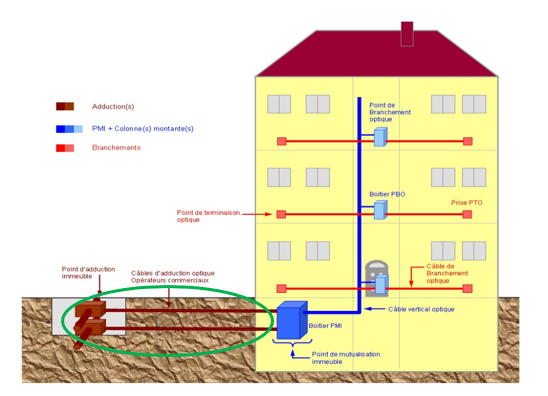9 March 2017: Fibre-to-the-building connections under the so-called "Faber" co-investment contract between SFR and Bouygues Telecom

The Autorité de la concurrence fines Altice and SFR Group 40 million euros for failing to honour commitments
under the "Faber" contract, made when SFR was taken over by Numericable.
It also orders a number of injunctions subject to periodic penalty payments.
| Background Numericable’s acquisition of SFR (referred to hereafter as Numericable-SFR) was authorised by the Autorité de la concurrence in October 2014 (Decision 14-DCC-160 of 30 October 2014), subject to a number of commitments (see the press release of 27 October 2014) to avert the identified risks of harm to competition. Among these risks, the Autorité considered that the operation was liable to undermine Numericable-SFR1 ’s incentive to honour its commitments to the Public Authorities and its co-investors (mainly Orange and Bouygues Telecom) with regard to the deployment of optical fibre. Given the network’s very high coverage rate in high-density areas, the recently-acquired operator would have little incentive to pursue the deployment (a significant part of the FttH end-user access points that SFR planned to deploy in high-density areas had been made redundant by the Numericable network after the operation). The Autorité noted that Bouygues Telecom was most likely to be affected, given its contractual ties with SFR in the so-called "Faber contract" for co-investment in optical fibre infrastructure in high-density areas. For this reason, clearance for the operation was made conditional on the new entity’s compliance with specific undertakings concerning the Faber contract: - the new entity was to pursue deployment and especially to carry out the final connections to buildings so that Bouygues Telecom could obtain the benefit of the deployments it had co-financed by marketing its fibre packages to the homes concerned;
- it was also to honour its maintenance obligations against the network vis-à-vis its co-contractor in a transparent, non-discriminatory manner so that Bouygues Telecom could rely on a high-quality network.
These commitments were aimed at preventing the new entity from suspending the completion of these connections in high-density areas. The Autorité de la concurrence has observed that they have not been met: the pace of the connections slowed noticeably after completion of the operation, and has only really resumed after a year, running substantially behind the agreed schedule. Moreover, this non-compliance was accompanied by a deterioration in the network maintenance conditions, which penalised Bouygues Telecom. The Autorité has handed down a fine of 40 million euros, together with injunctions designed to oblige the operator to meet its commitments. There are also provisions for periodic penalty payments per concentration point and per day late. |
THE SO-CALLED "FABER" CO-INVESTMENT CONTRACT SIGNED BY SFR AND BOUYGUES TELECOM
The deployment of optical fibre, which should eventually replace the copper network is a major industrial and economic challenge. It offers consumers and businesses very high-speed Internet using, at the moment, two types of network:
- upgraded coaxial cable, in optical fibre, to the foot of the building (FttB, Fibre to the Building), owned exclusively by Altice/SFR Group, ex-Numericable;
- optical fibre to the home (FttH, Fibre to the Home), currently being deployed by the telecom operators.
On 9 November 2010, Bouygues Telecom and SFR signed a co-investment agreement to deploy a horizontal optical fibre network in the main French cities, located in high-density areas, within the meaning of the French Telecommunications and Posts Regulator (ARCEP) regulations. The contract concerns 22 municipalities, including Paris.
While the Faber contract is based on the principle of sharing the costs and investments between the parties, it is nevertheless led by SFR, which acts on both operators’ behalves to carry out the deployment, including the services involved in the connections, as well as the maintenance of the shared infrastructure.
The deployment operations involve horizontal deployment of the FttH network to the street near buildings (i.e. to the "connection point") and installation of the "last leg" connecting the network to the buildings.
In practice, connection consists in laying cables (circled in green on the diagram) to link the "horizontal" network to the "vertical" network (shown in blue on the diagram) already installed in the building by the "building operator" From a technical point of view, the connection is made at the building’s "concentration point" (BCP), generally situated at the foot of the building either inside, or outside the building, according to the cases predefined by ARCEP.

Caption
Adduction(s) : connection(s)
PMI + colonne(s) montante(s)
Branchements : breakouts
Point de branchement optique : Optical Branch Point (OBP)
Boitier PBO: OBP unit
Point de terminaison optique: Optical Termination Point (OTP)
Prise PTO : OTP socket
Câble de Branchement optique : Optical cable
Boitier PMI : BCP Unit
Câble vertical optique : Vertical Optical Cable
Point de mutualisation immeuble : Building Concentration Point (BCP)
Point d’adduction immeuble: Building Connection Point
Câbles d’adduction optique Opérateurs commerciaux : Commercial Operators’ Optical Connection Cables
THE RISK IDENTIFIED BY THE AUTORITÉ DE LA CONCURRENCE WITH REGARD TO THE DEPLOYMENT OF FIBRE
On examining Numericable’s acquisition of SFR, the Autorité noted that, prior to the operation, SFR was a major stakeholder in co-financing FttH networks.
The Autorité considered that the operation was liable to undermine SFR’s incentive to honour its commitments to its co-investors to deploy optical fibre, insofar as the operator would have little incentive to pursue its co-investment efforts in FttH networks throughout the area in which upgraded cable could provide data speeds on a par with fibre ; a significant part of FttH outlets that SFR was planning to deploy in very high-density areas would be redundant with Numericable’s cable network after the operation.
The Autorité noted that Bouygues Telecom could be particularly impacted, given the contractual ties established with SFR under the Faber contract. On the eve of Numericable’s acquisition of SFR, Bouygues Telecom had already co-financed significant horizontal deployments of optic fibre through the contract. However, SFR had completed the connection for a very small number of these homes, preventing Bouygues Télécom from benefiting from its investments.
THE COMMITMENTS MADE BY ALTICE AND NUMERICABLE
To overcome the competition issues identified by the Autorité, the new entity made the following commitments:
1) To connect buildings with access to vertical fibre to the horizontal optical fibre network for the geographic scope covered by the Faber contract ;
For buildings already connected to vertical fibre by building operators at the date of the authorisation decision ("stock"), the new Altice-SFR Group was to connect them within two years, barring duly justified connection problems.
For buildings which would be connected to fibre by the building operator following the authorisation decision ("flow"), Altice-SFR Group was to connect the buildings ordered by Bouygues Telecom each quarter, again barring duly justified connection problems, within three months. This requirement had been set in consideration of the regulations, which impose a three month "consideration" period on building operators2 before any marketing of fibre packages to residents of homes connected. Thus ensuring equal opportunities for other operators and preventing the operator who connected the building to the fibre network from pre-empting the market.
2) Ensure transparent, non-discriminatory network maintenance
Altice/SFR Group had undertaken to maintain the infrastructure per the conditions laid down in the contract, in a transparent, non-discriminatory manner with regard to Bouygues Telecom, to allow the latter to fully leverage the network it had co-financed.
FAILURE TO HONOUR COMMITMENTS
1) Processing time for connections not respected
It appears that Altice/SFR Group has failed to honour its commitments, notably by connecting fewer concentration points than it was supposed, having estimated that these “excluded” concentration points weren’t part of the commitments’ scope. Between 12% and 19% of the required connections have been left out of the scope of the commitments.
In total, over half of the planned connections (58%) were not carried out.
- For the "stock", two years after the decision, only one-third of the connections have been carried out, the other connections that were attempted being classified as “definitive failure”. While Altice/-SFR Group has pointed to technical problems to account for the unsuccessful attempts to carry out the connections, it has not provided any precise explanation for the difficulties encountered, nor taken the necessary steps to solve them.
- For the "flow", only half of the buildings that Bouygues wanted to connect have actually been connected, without Altice/-SFR providing any precise documentation of the difficulties met. The three-month period that Altice/SFR Group should have adhered to was only very partially respected, leaving the way free for competing operators to pre-empt prospective customers.
2) Degraded maintenance
Information on file shows that the time taken to deal with the incidents that occurred was manifestly excessive, regarding in particular the standards specified in the contract. It also appears that Altice/SFR Group failed to take the necessary steps to provide efficient maintenance, especially to address certain technical facilities (absence of air conditioning), resulting in service interruptions for subscribers. The Autorité notes that the deterioration in the quality of the FttH network pursuant to the Faber contract was mainly detrimental to Bouygues Telecom because, after the decision to take over SFR, Altice/SFR had adopted a new strategy consisting in only marketing offers using modernized cable network in areas in which it had both this network and an optical fibre network.
A € 40 MILLION FINE
For two years, from the date of the Autorité decision to authorise the acquisition of SFR subject to certain conditions to the decision made today, Altice/SFR Group has only very partially fulfilled its commitments and has not taken steps to meet them properly.
Altice/SFR Group, which is a powerful group with substantial resources for economic and legal analyses, could not have been unaware of the binding nature of the commitments or the consequences of its behaviour on the state of competition in ultra-fast broadband, and especially on that of its co-contractor.
By refraining from carrying out the connections to which it was committed, it deprived Bouygues Telecom of the possibility of marketing fibre packages to the homes concerned. This weakened Bouygues Telecom’s position at a time when it was an active competitor on the high-speed and very high-speed Internet sector.
The Autorité has accordingly fined Altice/SFR Group 40 million euros. It has also pronounced a number of injunctions to ensure that Altice/SFR Group refrains from pursuing these practices. More specifically, it has drawn up a new calendar for Altice/SFR Group, with successive stages of completion and progressive periodic penalty payments to force the group to carry out the connection of all of the concentration points not yet connected. Accordingly, Altice/SFR Group must have connected all of the concentration points (within the “stock” and the “flow”) within 12 months, barring duly justified connection problems. An independent representative will be appointed to monitor the maintenance conditions and progress with the connections, and will submit a report to the Autorité every three months on the progress of carrying out the injunctions.
|
Injunctions subject to a periodic penalty payment By pronouncing injunctions subject to periodic penalty payment, the Autorité de la concurrence is applying for the first time, the provisions of the Law of 6 August 2015 for growth, activity and equality of economic opportunities (also known as the Macron Law), which gives it additional means should the commitments taken in the framework of a merger operation fail to be fulfilled. |
1 In June 2016, Numericable-SFR adopted the business name SFR-Group.
2 The regulations oblige the building operator (i.e. the operator who connected the building to the fibre network) to wait at least three months before activating any FttH access in the homes concerned, to allow third-party operators to carry out the connection in this period (the so-called "J3M" obligation, for "day + 3 months").
> See the full text of Decision 17-D-04 of 8 March 2017 regarding compliance with the agreement in the decision authorizing the acquisition of SFR by the Altice group, regarding the agreement with Bouygues Telecom of 9 November 2010
> Press contact: Chloé Duretête / Tel. : +33 (0)1 55 04 01 20 / Email
